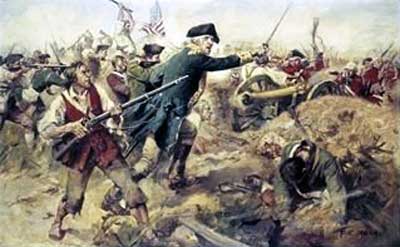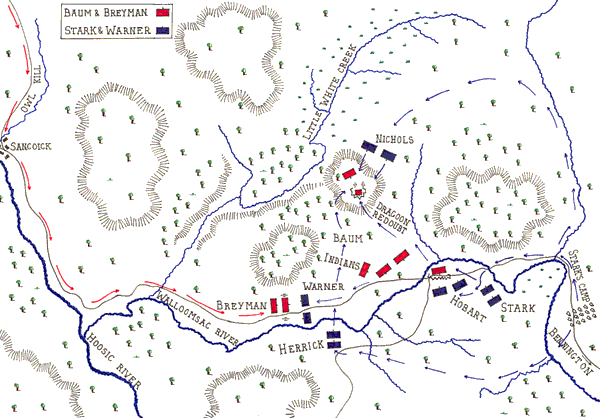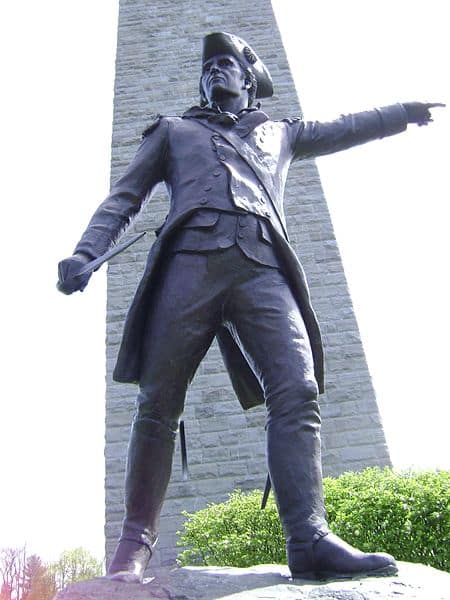The Battle of Bennington was an influential battle in the American Revolutionary War that took place on August 16, 1777, in Walloomsac, New York, about 10 miles from Bennington, Vermont. A rebel force of 2,000 men, primarily made up of New Hampshire and Massachusetts militiamen, led by General John Stark and reinforced by men led by Colonel Seth Warner and members of the notorious Green Mountain Boys, decisively defeated a detachment of General John Burgoyne's army led by Lieutenant Colonel Friedrich Baum, and supported by more men under Lieutenant Colonel Heinrich von Breymann. This victory set the stage for the defeat of Burgoyne at the Battle of Saratoga.

Baum's men of dismounted Brunswick dragoons, Canadians, Loyalists, and Indians totaled around 700 and were sent by Burgoyne to raid Bennington in the disputed New Hampshire Grants area for horses, draft animals, and other supplies. Unfortunately, Burgoyne had faulty intelligence as he ran into 1,500 militiamen under the command of General John Stark. This fatal mistake would cost Burgoyne one of his commanders when Baum fell and many casualties.
Bennington was a key victory in the American Revolutionary War, and it does not receive the recognition that it deserves. One could argue that without Bennington, there would not have been a victory at Saratoga since the Battle of Bennington reduced Burgoyne's men by close to 1,000, hurt his standing with the Indians, and deprived him of necessary supplies. These were all things that led to Burgoyne's surrender at Saratoga. The victory at Bennington rallied Americans to the cause for Independence. While numbers for Burgoyne began to drop, The army under Horatio Gates began to swell.
Background
After the British victories at Hubbardton, Fort Ticonderoga, and Fort Anne, General John Burgoyne's plan for the Saratoga campaign was to capture Albany and gain control of the Hudson River Valley, dividing the American colonies in half. This ambitious plan was predicated on the belief that General William Howe would also aid in Burgoyne's northern invasion from Canada and Barry St. Leger would come from the west. However, Howe did not do that. Instead, Howe made one of the most puzzling moves of the war when he went on to capture Philadelphia after the Battle of Brandywine and the Battle of Germantown, which had little tactical significance. Barry St. Leger and his men were defeated at Fort Stanwix, and Burgoyne was left vulnerable to the Americans.
British Forces
Burgoyne's plan to capture Albany was initially successful. He soundly defeated Seth Warner and his men at the Battle of Hubbardton and had gained the support of Indians and Loyalists. However, the Americans under Major General Philip Schuyler made Burgoyne's trek to Albany long and difficult. They destroyed a key road and cut down trees to slow their way. This slow process caused Burgoyne to eat up his supply. His fears of low supplies escalated when he received word that Howe would not be advancing up the Hudson River valley and planned to move to Philadelphia. In response to a proposal first made on July 22 by the commander of his German troops, Baron Riedesel, Burgoyne sent a detachment of about 800 troops under the command of Lieutenant Colonel Friedrich Baum from Fort Miller on a foraging mission to acquire horses for the German dragoons, draft animals to assist in moving the army, and to harass the enemy. Baum's detachment was primarily made up of dismounted Brunswick dragoons of the Prinz Ludwig regiment. Along the way, it was joined by local companies of Loyalists, some Canadians, and about 100 Indians, and a company of British sharpshooters. Baum was originally ordered to proceed to the Connecticut River valley, where they believed horses could be procured for the dragoons. However, as Baum was preparing to leave, Burgoyne verbally changed the goal to be a supply depot at Bennington, which was believed to be guarded by the remnants of Warner's brigade, about 400 colonial militia.
American Forces
Unknown to Burgoyne, the citizens of the New Hampshire Grants territory (which was then disputed between New York and the Vermont Republic) had appealed to the states of New Hampshire and Massachusetts for protection from the invading army after the British capture of Ticonderoga. New Hampshire responded on July 18 by authorizing John Stark to raise a militia for the defense of the people. Using funds provided by John Langdon, Stark raised 1,500 New Hampshire militiamen in the space of six days, more than ten percent of New Hampshire's male population over the age of sixteen. They were first marched to the Fort at Number 4, then crossed the river border into the Grants and stopped at Manchester, where Stark conferred with Warner. While in Manchester, General Benjamin Lincoln, whose promotion in preference to Stark had been the cause for Stark's resignation from the Continental Army, attempted to assert Army authority over Stark and his men. Stark refused, stating that he was solely responsible to the New Hampshire authorities. Stark then went on to Bennington with Warner as a guide while Warner's men remained in Manchester. Lincoln returned to the American camp at Stillwater, where he and General Philip Schuyler hatched a plan for Lincoln, with 500 men, to join with Stark and Warner in actions to harass Burgoyne's communications and supply lines at Skenesboro. Baum's movements significantly altered these plans.
Prelude

Baum and his German forces left Fort Edward on August 9 to travel to Bennington. Along the way, his small force met minor skirmishes in which he took prisoners. The intelligence given to him by these prisoners gave a different story of Bennington then what was believed. He learned that there was an American force that was larger than expected. Baum's men pressed forward to Bennington and encountered a small American detachment that had been sent out to investigate Indians in the area. The Americans retreated and destroyed a bridge in the process. Baum sent a message to Burgoyne in which he stated that the forces were larger than expected but that he believed that the Americans would retreat. As he marched forward, he realized that he was wrong in that assessment and sent another letter to Burgoyne requesting reinforcements. Burgoyne responded and sent 550 men under Heinrich von Breymann. Baum's force would grow slightly before the battle when 100 loyalists joined his force.
Upon learning of the British movement, Stark began to set up defenses of his own. He sent a request to Manchester for support and then proceeded out of Bennington and set up a defensive line. He then sent out skirmishers to gauge the British. Despite the rain, the skirmishers killed 30 Indians. Stark was then reinforced by 350 Green Mountain Boys from Manchester and a band of Massachusetts militiamen that swelled his numbers to about 2,000 men.
Battle

On the afternoon of August 16, the weather cleared, and Stark ordered his men to be ready to attack. Stark is reputed to have rallied his troops by saying, "There are your enemies, the Red Coats and the Tories. They are ours, or this night, Molly Stark sleeps a widow." Upon hearing that the militia had faded away into the forest, Baum assumed that the Americans were retreating or redeploying. However, Stark had decided to capitalize on weaknesses in the Hessian's widely distributed position and had sent sizable flanking parties to either side of his lines. These movements were assisted by a ruse employed by Stark's men that enabled them to safely get closer without alarming the opposing forces. The Hessians, most of whom spoke no English, had been told that soldiers with bits of white paper in their hats were Loyalists and should not be fired on; Stark's men had also heard this, and many of them had suitably adorned their hats.
When the fighting broke out around 3:00 PM, the Hessian position was surrounded by gunfire, which Stark described as "the hottest engagement I have ever saw, resembling a continual clap of thunder." The Loyalists and Indian positions were overrun, causing many of them to flee or surrender. This left Baum and his Brunswick dragoons trapped alone on the high ground. The Hessians fought valiantly even after running low on powder and their ammunition wagon. In desperation, the dragoons led a saber charge in an attempt to break through the enveloping forces. Baum was mortally wounded in this final charge, and the remaining Hessians surrendered.
After the battle ended, while Stark's militiamen were busy disarming the prisoners and looting their supplies, Breymann arrived with his reinforcements. Seeing the Americans in disarray, they immediately pressed their attack. After hastily regrouping, Stark's forces tried to hold their ground against the new Hessian onslaught but began to fall back. Before their lines collapsed, Warner's men arrived on the scene to reinforce Stark's troops. The pitched battle continued until dark when both sides disengaged. Breymann began a hasty retreat; he had lost one-quarter of his force and all of his artillery pieces.
Battle of Bennington Facts: Aftermath

Total Hessian and British losses at Bennington were recorded at 207 dead and 700 captured; American losses included 30 Americans dead and 40 wounded. The battle was, at times, particularly brutal when Loyalists met Patriots, as, in some cases, they came from the same communities. The prisoners, who were first kept in Bennington, were eventually marched to Boston.
The fallout of the Battle of Bennington for Burgoyne was significant. He lost about 1,000 men and all of his Indian support. With the loss of the Indians, Burgoyne lost his eyes, and his reconnaissance suffered because of it. He was also unable to sufficiently supply his armies needs since he now had to depend on his own supply lines, which were extremely long and cumbersome. This loss of supplies was the main reason he had to surrender at Saratoga a few months later.
John Stark became a national hero and was awarded by John Hancock and recognized by many of his fellow officers for his accomplishments at Bennington.
Battle of Bennington Facts: Online Resources
- Wikipedia - Bennington
- Battle of Bennington Monument
- The Battle of Bennington: Soldiers & Civilians
- Library of Congress Collection of Revolutionary War Maps
- West Point Battle Maps of the American Revolution
- Journal of the American Revolution
- Guide to the Battles of the American Revolution
- DIY Genealogy - Finding your Revolutionary War Ancestor
- The History Junkie's Guide to the American Revolutionary War
- The History Junkie's Guide to American Revolutionary War Battles
- The History Junkie’s Guide to the American Revolutionary War Timeline
- The History Junkie’s Guide to the 13 Original Colonies
